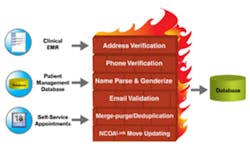Keeping data verified, clean and secure is critical medicine for today's complex patient information.
Bud Walker
Evaluating and maintaining data quality is complex in any industry. However, the uniquely complex and non-stop aspects of healthcare data management complicate the process significantly. Characterized by a steady stream of patient records and evolving contact points, information must be managed effectively within a deep well of legacy data. Coding and filing claims, and constant updating of medical records, are prime examples of routine data-entry points that can very quickly degrade the quality and resulting effectiveness of an organization's database. Administrators and overall health networks are further challenged by socioeconomic changes in healthcare plans and federal requirements for compliance with data security and privacy.
Preventive medicine is often the best approach, and it's no different in sustaining healthy data. Long-term success requires implementing a data-quality firewall that provides instantaneous, point-of-entry data-cleaning tools that prevent bad data from entering the database in the first place. From there, a healthy regimen of ongoing data-quality processes is advised, as even good data changes and degrades over time. Data simply isn't stagnant, and providers must manage clinical and business processes effectively with the right on-site data-quality tools.
Nonstop data requires nonstop data quality
“Assuming the data is 'just fine' is not a sufficient data-quality program for a vibrant healthcare system. In fact, committing to data quality is an essential initiative, as administrators and practitioners alike rely heavily on the constant flow and high volume of shared information,” says Andy Hayler, CEO of analyst firm The Information Difference. “Clinicians may be primarily concerned with providing top-notch care, but today that is driven significantly by telemedicine and electronic communications. Recognizing the value of accurate data in this process is helping to improve treatment, diagnosis and overall patient health.”
On-site data-quality solutions enable effective maintenance of patient data, while allowing providers to meet privacy and compliance guidelines securely, thoroughly and automatically.
Achieving a single view of the customer (the patient, in this case) requires clean, standardized data that effectively matches, links and purges records. Simple problems arise, such as “householding,” in which residents of the same home may share the same surnames, be a party to divorce or even have changed names. Solving these basic issues at the point of data entry is optimal.
The flux of data is staggering, with more than 43 million Americans (one in six) moving annually and as many as 33 percent skipping the step of updating their address records. These basic challenges represent data that degrades very quickly, especially for healthcare facilities attempting to provide patient care to a moving target. Has marriage or divorce resulted in a name change? Are data fields combining or separating first and last names? Does the patient reside on 12th Avenue or Twelfth Street? Published research from The Data Warehousing Institute indicates that these types of common inaccuracies account for nearly 76 percent of data-quality errors. The wave of bad data can grow quickly, especially when you factor in daily changes in U.S. carrier routes and the more than 100,000 changes monthly to the USPS address data file such as additions, deletions and modifications.
Because a patient's well-being relies in part on data integrity, healthcare organizations are moving to develop policies of routine updating and verification of information. Ongoing data hygiene is reflected in accurate patient records and is achieved with incremental as well as batch prevention of new duplicate records. Simple mistakes such as typos or improper formatting (Are we last name first? Do we ever combine data fields?) can be eliminated, preventing duplicate records entirely. When providers implement the correct data tool, they streamline and fine-tune data operations by reducing excessive rules-based matching and replacing it with state-of-the-art matching algorithms. This sophisticated level of data hygiene has business value far beyond patient care, consolidating master data into individual and unique customer records, reducing printing and mailing costs for providers.
Taking an enterprise approach to healthcare data management
Healthcare providers are meeting these data goals by integrating dedicated servers to house contact-data verification and enrichment programs. Standard data fields such as name and address can be associated with customized information determined to be of specific value to the provider. Verifying this information (name, old and new addresses, phone, e-mail, name parsing, geocoding and more) can result in managing millions of records hourly. Such high-level data demands are ideally handled with dedicated computer power that enables enterprise-level speed and processing.
Bad data can result in duplicate records, returned mail and costly errors in patient communications. Melissa Data's Data Quality Suite is a toolkit of APIs that works to standardize, verify and correct addresses, telephone numbers, e-mail addresses and names so practitioners have clean, usable patient contact data on an ongoing basis.
These same systems that handle data processing so efficiently also allow providers to cluster operations with other systems and devices, increasing scalability, throughput and redundancy. Processes can be automated by implementing “smart scripts,” automatically collecting and installing the most current contact datasets on a predetermined weekly, monthly or quarterly basis.
Further, privacy and compliance needs can be met and any real-time failover can be addressed quickly by hosting a data-quality server on-site. “While managing patient data for the most effective treatment and care, healthcare providers must also meet security and compliance guidelines established by HIPAA, Sarbanes-Oxley and other regulations,” says Hayler. “These are significant drivers that have providers embracing data quality as a business necessity, made easier by the ability to enrich, scrub and validate data entirely within their own operational network.”
Keeping data fit for the long term
Healthcare systems are rising to place greater value on the power of data by identifying patients properly, channeling communications effectively and integrating patient information from a range of varied sources. These functions may seem like the basics for major healthcare organizations, but they've never been more important as providers are facing ongoing shifts in technology, a focus on accommodating an aging population and healthcare costs that are increasing steadily. On-site data-quality operations are helping medical professionals manage data quality automatically and securely — complementing privacy and compliance requirements and keeping clinicians focused on delivering excellent patient care.
Bud Walker is director of data quality solutions at Melissa Data.
Click Here for more information on Melissa Data solutions




